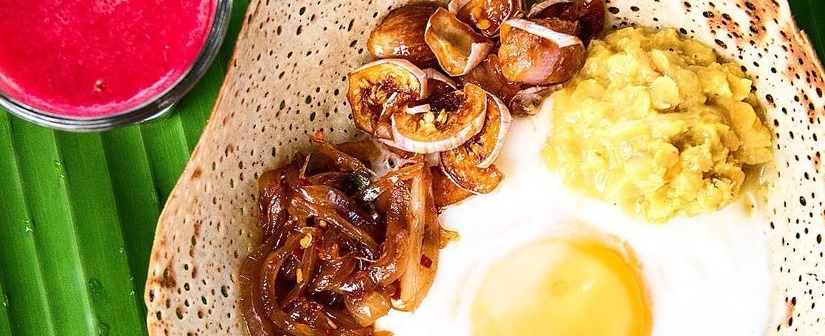Sri Lanka is a natural destination for a holiday without gluten.
If you don’t want to eat anything containing gluten, then Sri Lanka is the place for you. Gluten is found in wheat, barley and rye flour and is a disaster to those hypersensitive to it, as well as bloat-making to many of us.
Although freshly-baked bread from a wood-fired rural brick oven is about the best bread you’ll ever taste, it’s made with wheat flour. In Sri Lanka, if you can’t eat that warm bread with a crispy crust, there are plenty of natural, wheat-free products that are just as delicious.
Gluten free Sri Lankan hoppers
You can chuck away your fried egg and toast for breakfast and happily enjoy the Sri Lankan version: Sri Lankan hoppers with egg. This is like a crisp, savoury crepe with an egg gently poached in its centre. Gram flour or rice flour, with a splash of coconut milk, is mixed to make the crepe, which is cooked over a fire (better a coconut charcoal fire for flavour) in a bowl-shaped hopper pan (like a mini wok) while covered with a lid.

You can eat Sri Lankan hoppers with egg by themselves or lather them with local chutneys like pol sambol (grated coconut and chillies) or seeni sambol (sweet fried onions). Dhal (lentil) curry is a perfect accompaniment or for a real hearty breakfast, smothered with hill country beef curry. Sri Lankan plain hoppers without the egg, can be used for mopping up relish or curry. Sri Lankan Plain hoppers are also served at night and you could be adventurous by having them spread with butter and Marmite (that’s gluten-free, right?) or folded around a chunk of cheese.
A flatbread known as Roti, if made with Kurakkan or other smaller coarse grains of the millet type, is good as a wheat-bread substitute but sometimes cooks use wheat flour to make roti. It is safer to avoid Kottu Roti as that comprises chopped up godamba roti (wheat-flour pastry rolled and grilled as thin as a handkerchief). Kotti Roti is a snack that shouts because it’s made with a great deal of noisy chopping of the pastry by the cook banging two metal blades up and down on a griddle. All sorts of veggies, egg and sometimes chicken are added to the mix.
Other bread type confections are made with ulundu flour, also known as orid, pale white in colour and created by grinding white lentils into a fine powder. This is commonly used for making delicious dosas, idlis and uttapams. It is also used to make savoury snacks such as muruku and papadam. It’s easily available in local supermarkets and can even be used for home-cooking with the addition of coconut milk, yeast and an egg to make exotic blinis.
As well as gram-flour bread, Sri Lanka abounds in wholesome foods that are naturally gluten-free. Visit a local market to see the fruit and vegetables on display, including roots such as manioc, sweet potatoes and yams as well as breadfruit and jackfruit. And of course, there is fresh meat, fish and seafood too, all gluten-free.
Village cooks will not usually use wheat flour to thicken curries (that is achieved by sweating down sliced onions) although they might add cornflour. In mainstream hotels, however, the curries are made for convenience rather than authenticity, so better to stick to their ersatz Western food rather than risk the chance of gluten intake.
Sri Lanka Holiday Guru Tip
Sri Lankans prefer to eat with their fingers, but there’s a technique. The idea is to use only the right hand (the left is for ablutions) and roll a morsel of food into a ball and pop it into your mouth. Don’t pick up a chicken leg and gnaw at it with your teeth; instead, tear off the flesh with your fingers and slide it gently into your mouth. Sri Lankans learn how to eat by hand from childhood, so don’t worry if you can’t do it. If you think you’re going to make a mess, ask for a spoon; no one will mind.




